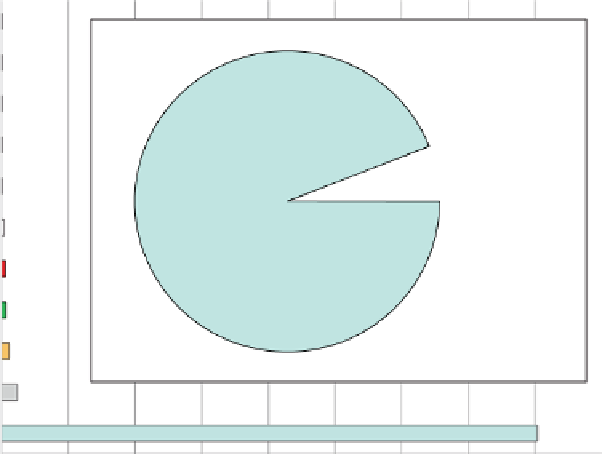Environmental Engineering Reference
In-Depth Information
Fig. 12.1
Existing ratio of
elements in space
㻝㻜
㻢
㻴
㻺㼡㼏㼘㼑㼍㼞
㼒㼡㼟㼕㼛㼚㻌㼕㼚
㼟㼠㼍㼞㻌㼏㼛㼞㼑
㻝㻜
㻠
㻿㼡㼜㼑㼞㼚㼛㼢㼍㻌㼑㼤㼜㼘㼛㼟㼕㼛㼚
㻴㼑
㻝㻜
㻞
㻻 㼕
㻱㼢㼑㼚㻌㼍㼠㼛㼙㼕㼏㻌㼚㼡㼙㼎㼑㼞
㻯
㻹㼓
㻺㼑
㻿
㻭㼞
㻯㼍
㻲㼑
㻝
㻻㼐㼐㻌㼍㼠㼛㼙㼕㼏㻌㼚㼡㼙㼎㼑㼞
㻺
㻺㼕
㻺㼍
㻝㻜
㻙㻞
㻲
㻭㼘
㻸㼕
㻝㻜
㻙㻠
㻯㼛
㻮
㻝㻜
㻙㻢
㻯㼡
㻮㼑
㻝㻜
㻙㻤
㻜 㻜 㻞㻜 㻜 㻜 㻜 㻜 㻜 㻜 㻜
㻭㼠㼛㼙㼕㼏㻌㼚㼡㼙㼎㼑㼞
㻳㼛㼘㼐
㻜㻚㻜㻜㻞㻥
㻭㼘㼡㼙㼕㼚㼡㼙
㻔㻞㻚㻣㻝㻑㻕
㻺㼑㼛㼐㼥㼙㼕㼡㼙
㻜㻚㻜㻢㻝
㼀㼕㼠㼍㼚㼕㼡㼙
㻜㻚㻞㻠
㻯㼛㼜㼜㼑㼞
㻔㻝㻚㻟㻑㻕
㼆㼕㼚㼏
㻔㻜㻚㻣㻣㻑㻕
㻸㼑㼍㼐
㻔㻜㻚㻢㻡㻑㻕
㻿㼕㼘㼕㼏㼛㼚
㻔㻜㻚㻠㻜㻑㻕
㻻㼠㼔㼑㼞㼟
㻔㻜㻚㻞㻣㻑㻕
㻹㼍㼓㼚㼑㼟㼕㼡㼙
㻜㻚㻣㻣
㻵㼞㼛㼚㻌㻒㻌㻿㼠㼑㼑㼘
㻔㻥㻟㻚㻥㻑㻕
㻺㼕㼏㼗㼑㼘
㻵㼞㼛㼚㻌㻒㻌㻿㼠㼑㼑㼘
㻔㻥㻟㻚㻥㻑㻕
㻝㻚㻤
㻿㼕㼘㼕㼏㼛㼚
㻢㻚㻥
㻸㼑㼍㼐
㻝㻝㻚㻝
㼆㼕㼚㼏
㻝㻟㻚㻞
㻯㼛㼜㼜㼑㼞
㻞㻞㻚㻜
㻭㼘㼡㼙㼕㼚㼡㼙
㻠㻢㻚㻟
㻝㻢㻝㻜
㻵㼞㼛㼚㻌㻒㻌㻿㼠㼑㼑㼘
㻜
㻞㻜㻜
㻠㻜㻜
㻢㻜㻜 㻤㻜㻜 㻝㻜㻜㻜 㻝㻞㻜㻜 㻝㻠㻜㻜 㻝㻢㻜㻜 㻝㻤㻜㻜
㻼㼞㼛㼐㼡㼏㼠㼕㼛㼚㻌㻔㼙㼕㼘㼘㼕㼛㼚㻌㼠㼛㼚㻛㼥㼑㼍㼞㻕
Fig. 12.2
Annual world production of metals
its production has been used as an economic criteria for a country. Even today, iron
and steel are so far the largest metallic products that other metals are called col-
lectively 'non-ferrous' metals. Figure
12.2
shows the global production ratios of
different metals, and it can be seen that iron and steel comprise about 94 % of the
total. The reason why iron has become such a popular material is not only the plen-
tiful availability of its resources and cheap price but also its unique characteristics










































































